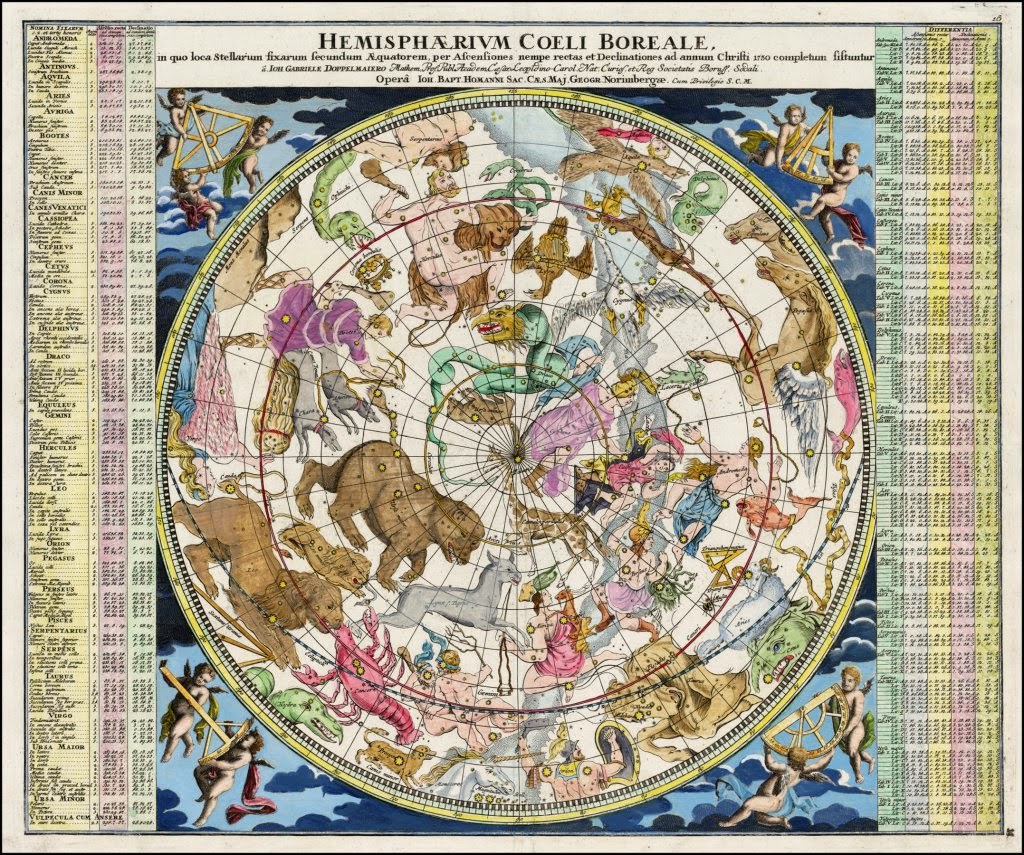
Map of the Constellations by Johanne Gabriele Doppelmayr, 1730
(Click on image to view larger)
In God’s very first contact with humanity after our forebears sinned in the Garden of Eden, Yahweh began to disclose to them His plan for their deliverance. He spoke of a Seed coming forth from the woman who would crush the serpent’s head. In doing so, this deliverer would be wounded by the serpent. These words provide an example of symbolic speech. The Seed crushing the serpent’s head is an allusion to Christ destroying Satan’s authority and tyrannical rule over mankind.
Yahweh recognized an immediate need to set hope in the heart of fallen man lest he be overwhelmed with despair and fall further into depravity and the snare of the enemy. We learn in the 4th chapter of Genesis that Yahweh gave man further instruction regarding the role of a sacrificial and substitutionary offering. We read of Abel bringing of the firstlings of the flock to present as a burnt offering before Yahweh. This occurred 2,500 years before the covenant of the Law was delivered to Moses upon Mount Sinai, yet there is no Biblical record of Yahweh speaking to these earliest of our ancestors about sacrifices and offerings. Through the historical narrative alone, we understand that this divine knowledge was communicated to man. Similarly, in the 8th chapter of Genesis we read of Noah presenting offerings to God upon an altar.
Genesis 8:20
Then Noah built an altar to Yahweh, and took of every clean animal and of every clean bird and offered burnt offerings on the altar.
Noah also understood the principle of offering, and presented sacrifices 1,000 years before the Law was given to Moses. Noah apprehended another truth of which no Biblical record exists of God having communicated it to man. He understood that only clean animals were suitable as offerings unto Yahweh. We don’t have a Biblical record of Yahweh identifying clean and unclean animals to man until the 11th chapter of Leviticus when the Law was delivered to Moses. However, it is possible for Noah to have discovered the distinction between clean and unclean animals through observation of which animals came to the ark by sevens, and which ones by twos.
Genesis 7:2-3
You shall take with you of every clean animal by sevens, a male and his female; and of the animals that are not clean two, a male and his female; also of the birds of the sky, by sevens, male and female, to keep offspring alive on the face of all the earth.
The way in which this commandment was presented to Noah seems to imply that the distinction between clean and unclean was already known. I do not believe it was by chance that Abel offered sheep of the flock to Yahweh upon the altar, rather than some unclean animal such as a pig. My purpose in sharing these things is to point out that there are things Yahweh communicated to early man of which no Biblical passage informs us. Four centuries before Yahweh delivered the covenant of the Law to Moses in the wilderness, it is recorded that God spoke to Isaac in the following manner:
Genesis 26:4-5
And I will multiply your descendants as the stars of heaven, and will give your descendants all these lands; and by your descendants all the nations of the earth shall be blessed; because Abraham obeyed Me and kept My charge, My commandments, My statutes and My laws.
Abraham’s life is recorded for us in the book of Genesis, a book which has no record of Yahweh delivering “commandments,” “statutes,” and “laws” to mankind. What were these commandments, statutes, and laws? In what way did they differ from the commandments Yahweh delivered to Moses? The apostle Paul informs us that Abraham did not enter into a covenant of Law. His covenant with God was one of promise.
Galatians 3:16-18
Now the promises were spoken to Abraham and to his seed. He does not say, “And to seeds,” as referring to many, but rather to one, “And to your seed,” that is, Christ. What I am saying is this: the Law, which came four hundred and thirty years later, does not invalidate a covenant previously ratified by God, so as to nullify the promise. For if the inheritance is based on law, it is no longer based on a promise; but God has granted it to Abraham by means of a promise.
Although God and Abraham did not enter into a covenant of Law, we are informed that Yahweh made known to Abraham certain of His statutes, commandments, and laws. We must conclude, therefore, that there were many things communicated to man by God for which we have no specific Biblical record. Of particular interest to our present study is the foreknowledge of the ministry of salvation and reconciliation that Yahweh appointed to His only begotten Son. That God communicated specific details of the salvific work of Christ can be deduced from the actions of the earliest descendants of Adam who offered sacrifices to God. These sacrifices foreshadowed the future perfect sacrifice of the Son of God.
Hebrews 11:4
By faith Abel offered to God a better sacrifice than Cain, through which he obtained the testimony that he was righteous…
“Faith comes by hearing, and hearing by the word of God.” It is discernible through the Scriptural comments about Abel’s offering that Yahweh had spoken to man about the principle of a substitutionary offering. By faith Abel was looking forward to that perfect sacrifice that Yahweh would one day provide as Yahshua, the Lamb of God, was offered up to atone for man’s sins. Even as Passover was delivered to Moses by God, and was to be observed annually until the Passover Lamb of God would be slain for the sins of the world, so too did men from the very earliest days offer up sacrifices to God, beginning with Abel. These had to be repeated annually as they were mere shadows of the perfect sacrifice to be realized in Christ.
Hebrews 10:1, 14
For the Law, since it has only a shadow of the good things to come and not the very form of things, can never by the same sacrifices year by year, which they offer continually, make perfect those who draw near… For by one offering [Yahshua] has perfected for all time those who are sanctified.
It is not through direct statement of the Scriptures that we are able to ascertain that Yahweh communicated to Adam and his descendants many things regarding the coming Messiah; the One who would bear the sins of the world and destroy the power of Satan. Rather, it is through a significant accumulation of details that we are informed of these facts. The preponderance of evidence points to the conclusion that Yahweh, at least in general terms, communicated to early mankind specific information about His plan for the redemption and restoration of humanity to divine fellowship.
Through a similar accumulation of evidence we are made to understand that Yahweh taught to men the message of their coming redemption through the constellations of the heavens. There is no specific verse stating this fact, but there are numerous passages that inform us of the following:
• Yahweh assigned to the stars a role to serve as signs, or oracles of divine truth. (Genesis 1:14, Psalm 19:1-4, Luke 21:11, 25, etc.)
• Yahweh legitimizes a number of constellations in the Bible, as well as the collective zodiac (mazzaroth), by mentioning them by name. (Job 9:9, 38:31-32, Amos 5:8, etc.)
• Yahweh states that He is the One who has assigned the stars to their courses and leads them forth in their seasons. (Job 38:31-33, Psalms 8:3, Isaiah 40:26, etc.)
• Yahweh declared that He created the constellations. (Amos 5:8)
• Yahweh used the stars to announce the birth of His Son to the magi. (Matthew 2:2, 9-10)
• In the Book of Revelation we are given an example of Yahweh speaking prophetically through signs in the heavens in the form of constellations. (Revelation 12:1-17)
Added to this, we have the historical record that shows a tremendous consistency in describing the number of constellations and their figures. One of the earliest extant writers outside of the Bible to make mention of the constellations of the zodiac is Homer, the Greek author of the Iliad and the Odyssey. The date which Homer lived is disputed, with some placing him as early as the 12th century B.C., while others argue for a more recent date around the 8th century B.C.. In the Iliad is found the following passage describing Vulcan’s shield.
There shone the image of the master mind;
There earth, there heaven, there ocean he design’d;
The unwearied sun, the moon completely round;
The starry lights that heaven’s high convex crown’d;
The Pleiads, Hyads, with the northern team;
And great Orion’s more refulgent beam;
To which around the axle of the sky
The Bear revolving points his golden eye;
Still shines exalted in the ethereal plain,
Nor bathes his blazing forehead in the main…
Eudoxos, a Greek mathematician and astronomer (astronomy was considered to be part of Greek mathematics), received a detailed map of the constellations (a celestial sphere) in 400 B.C. from Egypt. Eudoxos was a student of Plato, and produced a number of important astronomical writings. 130 years later, Aratus, a Greek man of acknowledged poetic ability, was encouraged by the King of Macedonia to render Eudoxos’ work into poetic form. Aratus penned Phaenomena and Diosemeia (English – Phenomena and Divine Signs) in 270 B.C.. The work became widely popular. Although this writing is no longer extant, details of this writing were mentioned by the Greek writers Aratus and Hipparchus. The apostle Paul even made reference unto the poetry of Aratus when he gave a speech at the Areopagus in Athens.
Acts 17:28
“As even some of your own poets have said, ‘For we also are His offspring.’”
Aratus described the entire zodiac in his poetry, with all of its constellations (44 were named by Aratus, though 48 are more typical), making mention of the mythology that went along with each figure. Aratus’ zodiacal figures agree with Homer’s, being more complete. Herodotus, a Greek historian writing in the 5th century B.C. states that the Greeks received their zodiac from Egypt. In the introduction to John Lamb’s translation of Aratus’ Phaenomena and Diosemeia (published 1848), the author writes:
Herodotus states that they borrowed the names of their twelve gods, their religious ceremonies, and their geometry from Egypt; and from the same people they are said to have obtained the celestial sphere. At the same time it is not probable that the Egyptians were the inventors of it. There is nothing of an Egyptian character in the figures depicted upon it; nor can this people establish any claim to the invention, being never celebrated for their astronomical discoveries. Their talents and skill were directed to Geometry and Architecture, in which two sciences they greatly excelled. But there are two nations whose claim to the introduction of the celestial sphere rests upon such strong presumptive evidence that it is difficult to refuse to either the credit of the invention. These are the Assyrians and the Phenicians (sic)…
At an early period after the deluge that family of the human race which constituted the great Assyrian empire spread themselves over the central plain of Asia, founded large cities, among others Babylon, where they carried all the arts and sciences of civilized life to high perfection. We know that they excelled in the knowledge of astronomy; much of which they might derive from the antediluvian patriarchs through Noah and his immediate descendants.
[Source: Aratus’ – Phaenomena and Diosemeia, John Lamb, D.D.]
Here we have one who believes that Adam’s early descendants had knowledge of astronomy and of the constellations, this knowledge being carried forward to postdiluvian civilizations through Noah and his sons. Dr. Lamb shared his opinion of the development of the zodiac, its symbols and mythology along two separate lines, one Babylonian, and the other Phoenician.
From the early history of the human race, as recorded in the first ten chapters of Genesis, and the continued records of their own empire, they would form a picture-history, commencing with Adam and reaching to their own times. Such I conceive to have been the Assyrian or Babylonian sphere; and that from it are derived the human figures on our celestial globe. The other sphere, of which the signs or constellations were the figures of animals, was of Phenician (sic) origin. This people at an early period having migrated to the eastern shores of the Mediterranean became the first of maritime nations…
They soon became a populous and powerful people, and were most celebrated for their maritime skill and boldness, and for the advancement they made in arithmetic and astronomy. Their mariners would carefully observe the positions and motions of the heavenly bodies, and would figure them upon a celestial sphere. And in so doing, what plan would they more probably adopt than that of taking for the signs or constellations the images which distinguished and gave a name to their celebrated ships? The learned Bochart has clearly shewn that the word Pegasus is of Phenician (sic) origin: Pag or Pega, “a bridle,” and Sus, “a horse,” forming the word “Pegasus,” ” the bridled horse,” no doubt the figure at the head, and the name of a ship. The body of this animal and of several others on the globe are cut in half, exactly representing the figure as it would appear on the head of a ship. Cetus, a whale, or great fish : a Dolphin : a Hydra, or seasnake: a Swan : a Ram : a Bull, are all such signs as ships would bear.
[Source: Ibid]
The notion that some of the signs of the zodiac were derived from the figureheads of ships is shared by other historians and authors. The major argument in support of this interesting idea is based upon the half-formed images of some of the constellations as they have historically been rendered. Such images might be observed on the prow of a sailing ship.
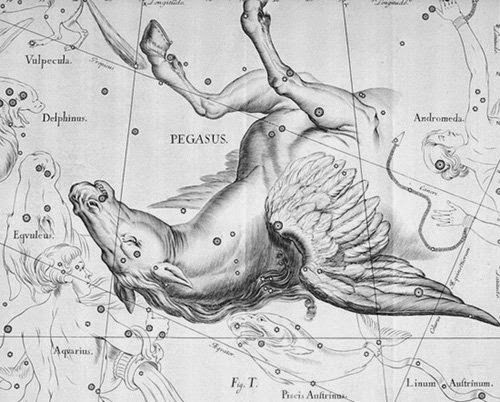
Constellation Pegasus
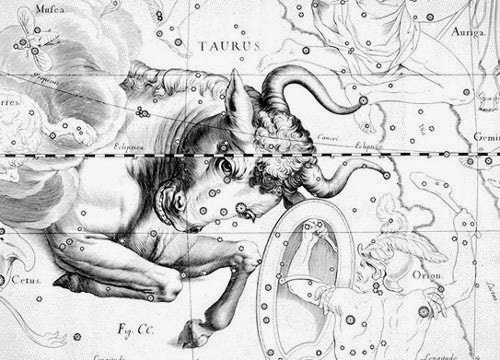
Constellation Taurus
During the time of Paul’s arrest and transfer to Rome as a prisoner, ships traditionally had figureheads adorning the prow. Luke describes one such emblem in the book of Acts.
Acts 28:11
And at the end of three months we set sail on an Alexandrian ship which had wintered at the island, and which had the Twin Brothers for its figurehead.
Alexandria was an Egyptian city, but it was Greek in culture, being founded by, and named after, the Greek conqueror Alexander the Great. “The Twin Brothers” is an apparent reference to Castor and Pollux who are depicted in the constellation Gemini, often referred to as “the Twins.” This Biblical narrative demonstrates credibly that zodiacal images were found on the prow of ships, but it does not resolve the question of which came first. Was the Phoenician zodiac derived from the images on their ships, or did the Phoenicians decorate their ships with much more ancient images found in their zodiac? Certainly, in the case of the ship that Paul and Luke sailed upon, the ship was adorned with the image of a zodiacal figure of much greater antiquity.
An argument against the ship’s figurehead theory is that many of the images of creatures in the zodiac are full body in their depiction, not being cut in half as one would expect on a ship’s prow. Regardless of what alterations may have been made by the Phoenicians to their zodiac, the more ancient one is certainly the Babylonian. Before the Phoenicians were ever settled along the shores of Syria and Canaan, their ancestors were gathered with all other men in the plains of Shinar at ancient Babel. There all men were of one tongue, and one purpose. There they had the knowledge of the constellations, so that when God scattered them they carried this science with them to all parts of the earth. This explains the great similarity in the zodiac found among scattered people of different tongues. Frances Rolleston, in the opening chapter of her book Mazzaroth, relates the great antiquity of the constellatons of the zodiac.
Now that the hieroglyphics of Egypt are interpreted, and the characters of Babylon and Assyria deciphered, should those far more ancient and more widely diffused, the primitive hieroglyphics of the whole human race, be neglected? Those, the great enigma of ages, transmitting far more important intelligence, shall they not seem worthy of investigation?…
These signs were known among all nations and in all ages. From the almost antediluvian chronologies of China, India, and Egypt, to the traditions of the recently discovered islands of the South Sea, traces of them are discerned, most clearly among the most ancient and earliest civilized nations. In the remains of Assyria they are recognized; in those of Egypt they are perfectly preserved; in those of Etruria and Mexico they are traceable.
This wide diffusion indicates a common origin, both of the race of man and of the symbols of astronomy…
The earliest positive evidence of the primeval existence of the signs is in the Chinese annals, where it is said that the Emperor Yao, 2317 years before the Christian era, divided the twelve signs of the zodiac by the twenty-eight mansions of the moon: but it is not said that he invented them. The Chinese national emblem of the dragon appears to be the dragon of the sphere, which was at that time the polar constellation, the brightest star in the dragon’s head having been the pole-star in the antediluvian ages.
The Signs are next alluded to by the patriarch Jacob, who in his dying blessing was held by the ancient Hebrews to have spoken of them as the appointed cognizances of his twelve sons, and as such they were borne on the standards of Israel in the wilderness.
The Egyptians, on whose early monuments the signs are found, acknowledged that they derived their astronomy from the Chaldeans. The Chaldeans attributed their science to Oannes, supposed to be Noah. The Arabs and Brahmins, among whom astronomy was early cultivated, seem to have derived it from Abraham, through Ishmael and the children of Keturah. The Greeks supposed their imperfect knowledge of the subject came through the Egyptians and the Chaldeans. The Romans are thought to have received through the Etrurians the names of the signs still in use among the European nations. The Etrurians are considered to have derived them, with their other arts and sciences, from Assyria. The early Greek poet Hesiod is said to have made use of Assyrian records. He mentions some of the constellations by the names they now bear…
A later Greek poet, Aratus, described the constellations such as we now have them, and by equivalent names. He gave neither history nor conjecture as to their date, their meaning, nor their origin. They were to him, as to us, of immemorial antiquity. Cicero, in translating from Aratus, says, “The signs are measured out, that in so many descriptions Divine wisdom might appear:” but he does not say in what manner. No attempt is made by any of these writers to explain the figures, or to assign any inventor to them… None of these earlier writers allude to any tradition concerning the meanings of the names and emblems of the constellations, nor as to where, when, or by whom they were originated.
[Frances Rolleston, Mazzaroth]
There is a very interesting book that can be read freely online, or downloaded, written in the year 1876 by George Smith, an archaeologist who was employed by the Department of Oriental Antiquities at the British Museum. The book is titled The Chaldean Account of Genesis. It describes a series of ancient Assyrian tablets that Smith was instrumental in discovering, cataloguing, and translating. Found among the ruins of the ancient Assyrian city of Nineveh were tens of thousands of fragments of clay tablets that were used as the writing material of the day. George Smith estimates that in the Royal Library at Nineveh there must have been about 10,000 complete tablets, though they no longer remain whole. The Assyrians would write upon the soft clay tablets and then fire them in a kiln to harden them. This rendered these writings relatively impervious to decay, though the media they were scribed upon was fragile. At this same site The Epic of Gilgamesh was found. It is considered the world’s first truly great work of literature. The first surviving edition of The Epic of Gilgamesh, a Babylonian version, is dated to the 18th century B.C.. The Epic of Gilgamesh includes an account of the flood of Noah.
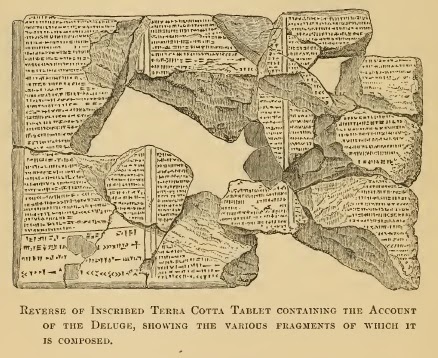
Clay Tablet Fragments From Nineveh
If you begin to look into the ancient history of astronomy, you will find the terms Chaldean, Babylonian, and Assyrian mentioned frequently, for they are arguably the most ancient societies in which evidence exists of the knowledge of astronomy or astrology. All three of these nations existed in what is referred to as “the Fertile Crescent” which includes the land lying between the Tigris and Euphrates rivers. This area is also called “the cradle of civilization.”
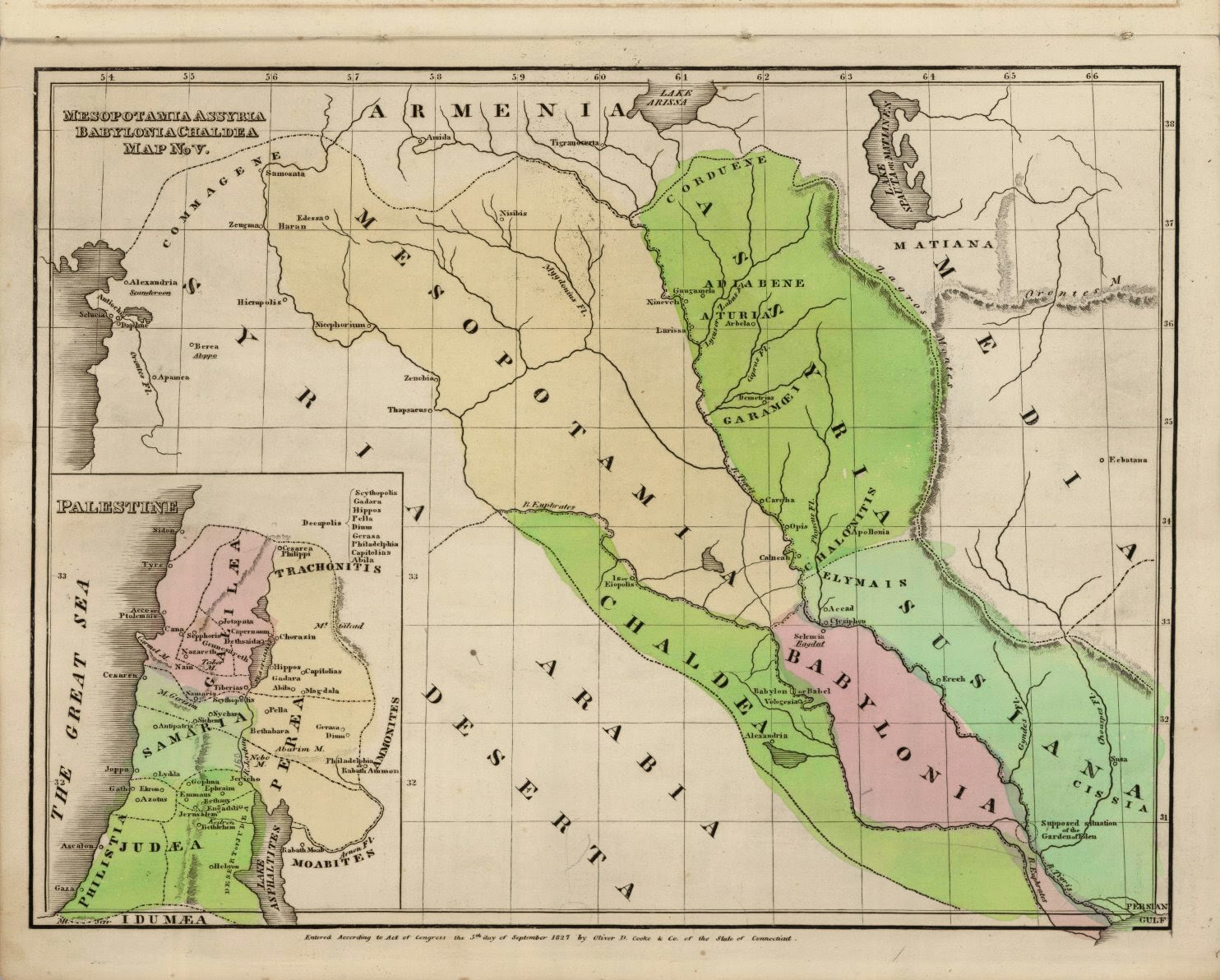
(Click on image to view larger.)
If you look closely you will see that the city of Babel, or Babylon, lies on the border of Babylonia and Chaldea. There was much interchange of culture and information between all three of these nations. Babylonia pre-dates Assyria, and the Assyrians acknowledge having received much of their knowledge of history and astronomy from the Babylonians. Because the Chaldeans became the dominant influence in Babylonia, and Babylonia had such an influence upon Assyria, one will often find the term Chaldean used to describe any of the cultures or peoples of these three nations. This seems to be the manner in which George Smith is employing the term, for the tablets he found were Assyrian, but he speaks of them as Chaldean.
Bible students will recall that the ten northern tribes of Israel were taken captive into Assyria. This occurred in 722 B.C. during the reign of the Assyrian king Sargon II. In 597 B.C. Judah was conquered by King Nebuchadnezzar of Babylon, and this began the first of three deportations to that nation, the last of which occurred in 582 B.C..
The Bible informs us that Babel was among the first of the great cities established after the flood of Noah. Ham was one of the three sons of Noah that went aboard the ark, along with his wife. Ham had a son named Cush, and Cush in turn was the father of Nimrod who was the founder of Babel.
Genesis 10:10-12
And the beginning of [Nimrod’s] kingdom was Babel and Erech and Accad and Calneh, in the land of Shinar. From that land he went forth into Assyria, and built Nineveh and Rehoboth-Ir and Calah, and Resen between Nineveh and Calah; that is the great city.
The date estimated for the founding of Babel is around 2300 B.C., approximately two centuries after the flood of Noah. At that time Noah and his sons would still have been alive as the Bible tells us that Noah lived 350 years after the flood, dying at an age of 950 years. The Genesis account in the Bible further informs us that Shem was 98 years of age when the flood ended and he lived 502 years after the flood, living to 600 years of age (Genesis 11:10-11). Shem was the father of the Shemites (Semites, or Semitic people), and a forebear of Abraham, thus his genealogy is carefully recorded. We are not told how long his brothers Ham and Japheth lived, but it can be assumed that they enjoyed a similar lifespan. Thus we see that the founding of Babel by Nimrod overlapped the lives of Noah and his sons. Any pre-flood knowledge they may have had of divine astronomy would certainly have been passed down to their descendants, eventually to be found at Babel.
The tablets of The Chaldean Account of Genesis parallel the Biblical book of Genesis in numerous areas. They begin with a lengthy description of the creation of the heavens and the earth, culminating in the creation of man. They include a narrative of the rebellion of a celestial being that corresponds to Satan, and the resulting war in heaven. They speak of man’s fall, and a terrible curse that results. The building of the tower of Babel is also noted on the Chaldean tablets. Although these events parallel the account of Genesis in the Bible, they depart from the Scriptural narrative in significant ways. There is evidence of much corruption and vanity entering into the tale, though the basic events remain recognizable.
The dates of the Assyrian Genesis tablets can be confidently dated to the reign of Assurbanipul who rose to power in 670 B.C.. However, these library copies of the Assyrian Genesis account were merely replicas of much older writings whose date of origin is very difficult to establish. George Smith shares that the Assyrian language remained unchanged for more than a thousand years which makes it difficult to establish a date for the original writing. What can be confidently asserted is that in the time between the flood of Noah in approximately 2500 B.C., and the copying of these tablets over 1,800 years later, sufficient time had elapsed for many corruptions to enter into the Assyrian stories. Sound doctrine devolved into myths and fables. Although the events of history and Biblical parallels can be discerned in a general sense, the narratives include many spurious additions and alterations by man.
My purpose in mentioning The Chaldean Account of Genesis is that on tablet five of the series the constellations are mentioned and their creation is ascribed to God. Following is a translation of a portion of the tablet performed by George Smith.
Fifth Tablet of Creation Legend
1. It was delightful, all that was fixed by the great gods.
2. Stars, their appearance [in figures] of animals he arranged.
3. To fix the year through the observation of their constellations,
4. twelve months (or signs) of stars in three rows he arranged,
5. from the day when the year commences unto the close.
6. He marked the positions of the wandering stars (planets) to shine in their courses,
7. that they may not do injury, and may not trouble any one…
If these statements are consistent with the rest of the information on these ancient tablets, we may conclude that the basic facts are true, but the details have suffered corruption due to the vanity of man’s thoughts. The tablets substantiate the fact that ancient civilizations believed that God was the creator of the constellations, passing the knowledge of them on to man. We also observe that the early Assyrians embraced a zodiac of twelve signs, while also having two additional groups of twelve constellations, making thirty-six in all.
I believe it is credible from both the Biblical and historical evidence to suggest that the constellations of the zodiac were originated by Yahweh, but through time, due to the darkness of man’s understanding and a tendency for vain speculations, the original identity of the constellations, and the message they conveyed, became corrupted. Nevertheless, there is still visible in what remains to this day shadows from which the original can be reconstructed, however imperfectly. This is what Christian scholars and writers such as Frances Rolleston, Joseph Seiss, E.W. Bullinger, Ken Fleming, E. Raymond Capt, J. Preston Eby, and others have labored to do.
(Dr. D. James Kennedy published a book on this subject in 1989 titled The Real Meaning of the Zodiac. I have not read it as it appears to be an entry level book on this subject designed for mass appeal. It likely provides a good summary of this subject, while not being a scholarly treatise. Chuck Missler has also authored a book on this subject, Signs in the Heavens, which is available as a Kindle e-book. Missler’s teaching also exists in tape format and he has numerous videos on this topic available on YouTube. Chuck Missler adds some interesting thoughts and information that are not mentioned by the other authors listed. For example he suggests that if the star names of a constellation are read in the order of their magnitude of brightness they form a message. He compares it to reading an acrostic.)
In the next chapter I will present a summation of the teachings of these authors in the following manner: Using the starting and ending points indicated by the symbol of the Great Sphinx, I will begin with Virgo and end with Leo. The twelve major constellations that lie along the plane of the ecliptic (the sun’s apparent path through the heavens) will be addressed in order, along with a brief account of the three minor constellations (decans) that are related to each of them, for a total of 48 constellations. For those unfamiliar with the connection between the Sphinx and the zodiac, I provide the following information.
The oldest complete depiction of the zodiac is found in the temple complex in Denderah, Egypt. On the ceiling of a chapel devoted to Osiris, the Egyptian sun god, is found the famous Denderah Planisphere, or Zodiac.
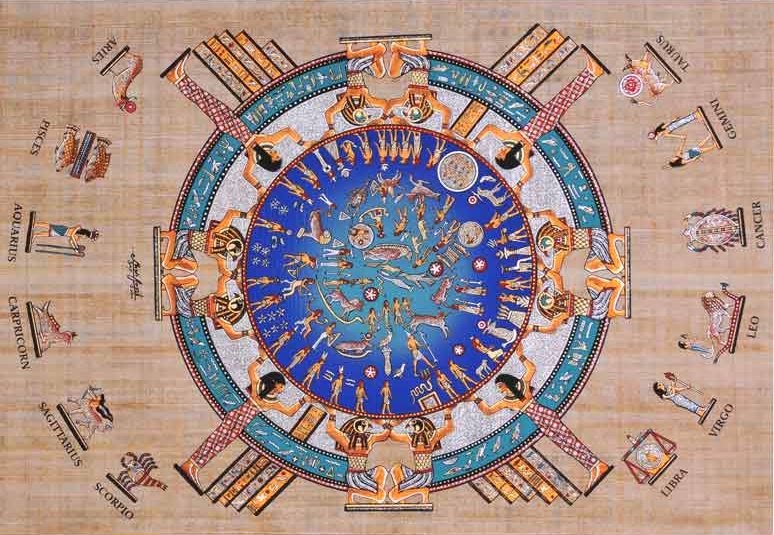
Depiction of Denderah Planisphere
(Note: The outer figures of the zodiac with their English names have been added for identification purposes, not being part of the temple ceiling in Denderah.)
Not far from Denderah is another ancient temple site in the town of Esne. At that location there is a zodiac displayed in a different form.

Esne Zodiac
Familiar images of the modern zodiac are readily apparent in these ancient depictions. One can easily see a lion (Leo), a virgin (Virgo) a scarab (the crab of Cancer), a bull (Taurus), a ram (Aries), two fish (Pisces), the twins (Gemini), a set of scales (Libra), a scorpion (Scorpio, or Scorpius), a centaur with a bow and arrow (Sagittarius), a half ram and half fish creature (Capricorn), and a man pouring out water from a vase (Aquarius). Although the creation of these reliefs depicting the zodiac are dated to about 2,000 years ago, it is estimated that the star arrangements of the Denederah Planisphere show the sky as it appeared more than 2,000 years earlier. Thus, it is believed by many to be a copy of a zodiac that was originally drawn 4,000 years ago which would place it close to the time after the flood of Noah.
Observe the image highlighted in red in the image of the zodiac from Esne. This is a figure of the Sphinx. It lies between the symbols for Virgo and Leo. It is understood by many archaeoastronomers (archaeologists who study the ancient star lore of past civilizations) that the Sphinx serves as a key pointing to the beginning and ending points of the zodiac. If a person were to turn back the clock to 4,000 B.C. (the approximate time of Adam’s creation) at the time of the Summer Solstice, they would find that “this solstice took place where the junction of Leo and Virgo is marked by the bright star Denebola” (a name meaning “The Lord who comes quickly,”) – Frances Rolleston, Mazzaroth.
What better way to denote the entire panoply of heavenly figures than with the image of the Sphinx? This imaginary creature has the head of a woman signifying the Virgin who would one day give birth to humanity’s redeemer. The Sphinx’s hind parts are the image of a Lion signifying the Lion of the tribe of Judah come back to reign upon the earth. Thus, the entire heavenly testimony, the glorious work of God, is represented in the image of the Sphinx.
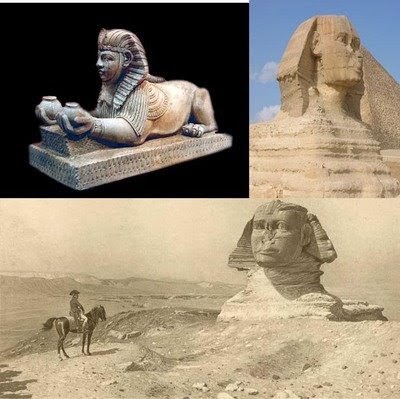
Sphinx
An argument could be put forth that the zodiac should start in Aries, for from antiquity Aries appears in lists as the first of the constellations. It is worthy of a short digression to make mention of the concept of astrological ages.
Most people have heard of the Age of Aquarius. It was popularized in the 1960s in the rock musical Hair which opened with the song Aquarius. Unfortunately, this has caused many Christians to associate any discussion of astrological ages with New Age religion and the hippie culture. A concept that relates to astrological ages is axial precession, or precession of the equinoxes. I will attempt to describe this in as simple a manner as possible.
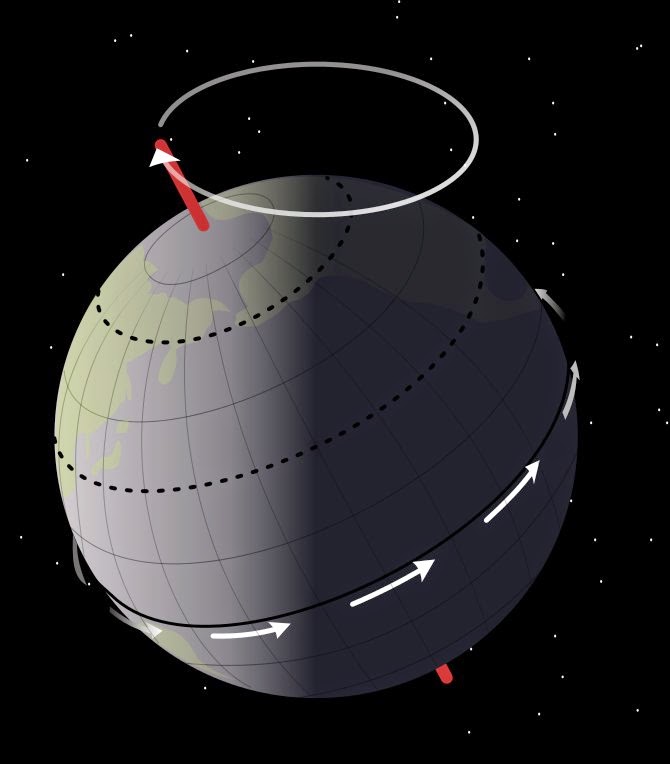
Axial Precession
Every 24 hours the earth rotates completely upon its central axis. This is illustrated by the white arrows above. The earth’s axis, however, does not remain stationary. As the earth rotates it acts much like a spinning top that wobbles. Imagine that the red line at the top of the image above is the axis of a spinning top. As the top itself is spinning very quickly, the axis point is making circuits in space. We can see this occurring with our naked eye when we spin a toy top, or a gyroscope, on a table. However, the wobble of the earth’s axis is very slow. It takes approximately 26,000 years for the axis of the earth to make one complete circuit. This astronomical time period is referred to as a “Great Year,” a term attributed to the Greek philosopher and mathematician Plato.
The following video illustrates these concepts.
It is interesting to note that in 13,000 years the tilt of the earth in relation to the sun will be the exact opposite of what it is now. That means that for countries in the northern hemisphere, summertime will be wintertime in 13,000 years, and vice versa for countries in the southern hemisphere.
Every 72 years the earth’s axis moves 1̊ (one degree) along the circle of its wobble. This movement is backwards in relation to the constellations of the zodiac. Rather than progressing in the order in which the sun travels through the constellations (Aries – Taurus – Gemini – Cancer – Leo – Virgo – Libra – Scorpio – Sagitarrius – Capricorn – Aquarius – Pisces), the wobble of the earth’s axis is moving in the reverse direction.
If the Great Year is divided up into twelve equal parts to correspond to the twelve constellations of the zodiac, we would find that the earth would be in each constellation for approximately 2,100 years. In rough measure, every two millennia the earth would enter into a new astrological age. This movement through the constellations is well illustrated in the following video. Note that there is an error in this video at the 0:48 second mark. It should list Aries as being 2,000 B.C. rather than 1,000 B.C.. You will note that all the other constellations are spaced equally at 2,000 years apart.
The dividing up of the constellations into twelve equal parts, each comprising 30̊ along the circle of the sun’s apparent motion through the heavens, is an invention of the Greeks. If one looks at the constellations it is evident that they do not each occupy the same amount of space in the heavens. Some constellations are spread out much further than others. There is also some overlap of the constellations. This makes it difficult to ascribe definite boundaries to the constellations, and to state definitively when the sun has moved from one constellation to the next.
From a prophetic standpoint, this lack of uniformity and the presence of overlap among some constellations, can be viewed as being divinely inspired in order to convey heavenly knowledge. Yahweh has not divided the ages of mankind, or the periods of history, up into neat, uniform segments. There is a great variation in the span of time appointed to the various works and dealings of Yahweh. Some works of God overlap other works. We see evidence of this as the age of Law that began with Moses at Mount Sinai gave way to the age of grace and life in the Spirit that commenced with the resurrection of Christ and the sending forth of the Spirit to indwell man. The apostle Paul speaks of this transition as being progressive, and not clearly delineated.
Hebrews 8:13
When He said, “A new covenant,” He has made the first obsolete. But whatever is becoming obsolete and growing old is ready to disappear.
The words “becoming obsolete,” “growing old,” and “ready to disappear,” indicate an ongoing process. The removal of the old covenant has significant overlap with the institution of a new covenant (not in an individual application, but in a corporate application). In one sense, the beginning of the new covenant can be clearly fixed to the hour in which Christ’s blood was shed on the cross. The blood of the Son of God sealed the new covenant.
Hebrews 9:16-18
For where a covenant is, there must of necessity be the death of the one who made it. For a covenant is valid only when men are dead, for it is never in force while the one who made it lives. Therefore even the first covenant was not inaugurated without blood.
Though the new covenant was inaugurated by the blood of Christ, not all men have at this time entered into the covenant. A firstfruits company have entered in, and in time all others will follow. The kingdom of Christ will grow until it fills the whole earth like the stone that was cut out of the mountain without hands in the vision of Nebuchadnezzar. Thus, in practice, we see that there is some overlap of the works of God. This is shown in the constellations of the heavens, for they do not all have neatly defined boundaries.
In 1922 the International Astronomical Union set forth proposed standards to define the boundaries of the constellations of the heavens. We cannot accept these boundaries that have been determined by man to be the same as those determined by God. Nevertheless, we see in these boundaries that the constellations each vary in size. The sun remains in each of the twelve constellations for an unequal amount of time. Using the IAU’s boundaries, we find that the sun abides in each house, or constellation, for the following length of time. (Note that the IAU recognizes Ophiuchus as the 13th constellation of the zodiac.)
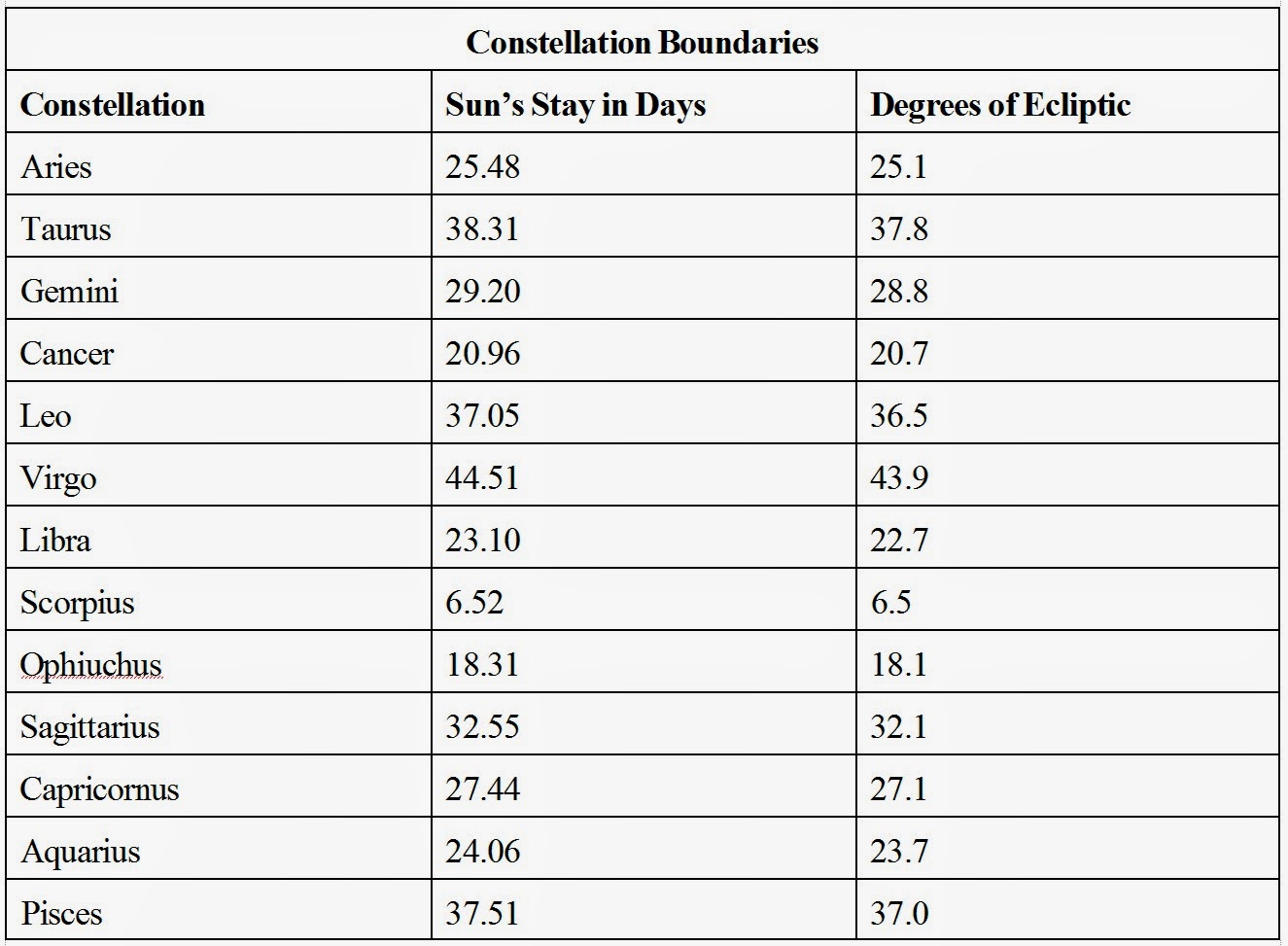
(Click table to view larger)
What this table reveals is that the section of the heavens each constellation occupies varies widely. From a low of 6.52 days and 6.5 degrees in Scorpio to a high of 44.51 days and 43.9 degrees in Virgo, the sun’s occupancy in Virgo (signifying the bringing forth of the sons of God) is nearly seven times that of its residency in Scorpio (signifying Satan stinging the heel of the man).
Many have attempted to determine the borders of astrological ages by measuring the boundaries of the constellations, but this is an exercise fraught with a great lack of precision. Depictions of the constellations vary. In many accounts there are constellations that share the same stars. The judgment of men pertaining to the boundaries of zodiacal figures varies. Some, like the Greeks, have approached the matter scientifically and assigned to each of the twelve main constellations an equal distance of thirty degrees in the heavens, and an equal amount of days. Others have looked to the images themselves to determine how much time to allot. As a student of the Scriptures, recognizing Yahweh as the Author of the constellations, I believe a more accurate means to determine the bounds of the constellations, and the ages they signify, is to compare them to the Biblical narrative. Here we find a remarkable correspondence with the astrological ages and Yahweh’s dealing with mankind.
Others have noted an unusual correspondence between the astrological ages and major events and dispensations in the Bible. Even the unregenerate have commented on this correspondence. The authors of the book Hamlet’s Mill believed that all of the world’s religious teachings (they referred to them as myths, including the teachings of the Bible) arose as attempts to explain the motions of the heavens. I can well imagine the “aha!” moment that the authors had when they discerned there was a very profound correspondence between the precession of the equinoxes through the constellations of the zodiac and the stories recorded in the Bible. Yet, approaching this subject from the perspective of unbelievers, they were unable to countenance the thought that these correspondences were the result of divine design. Instead, they imagined the Bible to be a book of myths that arose as attempts to convey knowledge about the motions of the heavens.
Sir William Drummund was another unbeliever who viewed the Hebrew Scriptures as something other than divine revelation. He wrote Oedipus Judaicus – Allegory in the Old Testament in the year 1811. Drummund believed the Hebrew Scriptures to be disguised astronomical records.
Drummund makes his case that at the time of Abraham, the Amorites first recorded the shift from the Age of Taurus to the Age of Aries as represented by the year commencing with the Ram (Aries) rather than the bull (Taurus). The Book of Joshua indicates that by the time of Moses the equinoxes had already shifted from Taurus to Aries as Moses had ordained that the civil year should commence with the month of Nisan (Aries) rather than the month of Taurus. The feast of the Passover is probably a celebration of the Age of Aries with the Paschal Lamb representative of Aries, traditionally associated with the symbol of the ram or sheep.
[Source: http://en.wikipedia.org/wiki/Astrological_age]
There are nearly as many schemes for calculating the beginning and end dates for astrological ages as there are astrologers and astronomers. Anyone can make a fair estimation of the ages in a general sense simply by study of the precession of the equinoxes, but setting precise dates is difficult for those who do not factor in the testimony of the Bible nor allow for divine direction of the stars. The Wikipedia article on Astrological Ages cites three different calculations for the beginning and end dates of the Age of Aries. Using the Greek method of allotting to each constellation 30 degrees along the plane of the ecliptic, two astrologers proposed the following dates.
• Neil Mann interpretation: began in ca. 2150 BC and ended in ca. 1 AD.
• Patrick Burlingame interpretation: began in ca. BC 2006 and ended in ca. BC 6.
[Source: Ibid]
Using the alternate method of using the constellation itself to set its boundaries, the following dates are set forth.
• Shephard Simpson interpretation: began ca. 1875 BC to ca. 100 AD.
[Source: Ibid]
What is evident in each of these views is that the age of Aries began after the flood of Noah, and ended at the beginning of the Christian era. I would suggest that postdiluvian men, with their tremendous focus upon the heavens, are responsible for establishing Aries as first in the list of zodiacal constellations. The reason their lists begin with Aries is because the earth after the flood entered the Age of Aries.
Sir William Drummund, who was cited earlier, proposed that the Age of Aries began in the days of Abraham. Abraham was born somewhere around the year 2,000 B.C.. This places his birth near the beginning of common estimates for the beginning of the Age of Aries. There is a remarkable event that occurs in Abraham’s life where a ram plays a significant role. After the birth of Isaac, when this son of Abraham is a youth, Yahweh instructs Abraham to take Isaac to a certain mountain and offer him there upon an altar as a sacrifice. This was an exceptional test of Abraham’s obedience to God. This event is recorded for us in the 22nd chapter of Genesis.
Genesis 22:7-14
And Isaac spoke to Abraham his father and said, “My father!” And he said, “Here I am, my son.” And he said, “Behold, the fire and the wood, but where is the lamb for the burnt offering?” And Abraham said, “God will provide for Himself the lamb for the burnt offering, my son.” So the two of them walked on together. Then they came to the place of which God had told him; and Abraham built the altar there, and arranged the wood, and bound his son Isaac, and laid him on the altar on top of the wood. And Abraham stretched out his hand, and took the knife to slay his son. But the angel of Yahweh called to him from heaven, and said, “Abraham, Abraham!” And he said, “Here I am.” And he said, “Do not stretch out your hand against the lad, and do nothing to him; for now I know that you fear God, since you have not withheld your son, your only son, from Me.” Then Abraham raised his eyes and looked, and behold, behind him a ram caught in the thicket by his horns; and Abraham went and took the ram, and offered him up for a burnt offering in the place of his son. And Abraham called the name of that place Yahweh Will Provide.
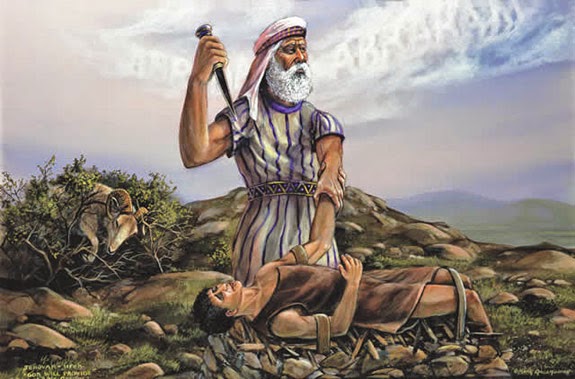
The image of the ram in the drawing above looks very similar to depictions of the constellation Aries.
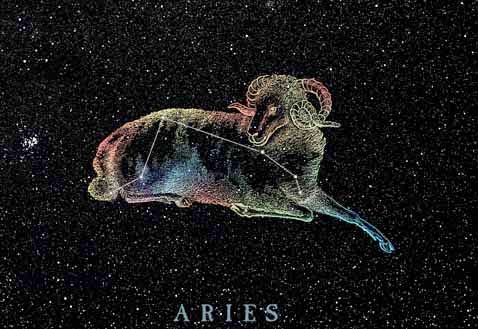
Without a doubt, this act of Abraham constitutes a great landmark in Yahweh’s dealing with humanity. It is an event worthy of being testified to in the heavens even as it has received significant space in the Bible. Because of Abraham’s fear of Yahweh and faith in His goodness, it was promised to Abraham on that day that God would make his descendants His personal possession.
Genesis 22:15-18
Then the angel of Yahweh called to Abraham a second time from heaven, and said, “By Myself I have sworn, declares Yahweh, because you have done this thing, and have not withheld your son, your only son, indeed I will greatly bless you, and I will greatly multiply your seed as the stars of the heavens, and as the sand which is on the seashore; and your seed shall possess the gate of their enemies. And in your seed all the nations of the earth shall be blessed, because you have obeyed My voice.”
Centering upon this event, a new nation was born. It would be a nation of priests who would be Yahweh’s own peculiar people. They would be entrusted with the oracles of God. From the seed of Abraham would come the Law and the prophets. Four hundred and thirty years later the first Passover would be observed, and the cental feature of the Passover would be a male lamb which would serve as a substitutionary sacrifice for mankind. The ram, therefore, is a most fitting image of this dispensation of God. The age would culminate in the sacrifice of the Son of God, who after the pattern of Abraham and Isaac, was offered up as a sacrifice by His Father. These two sacrifices represent the beginning and end dates of the Age of Aries.
As remarkable as this is, there is much more. The Age of Aries gave way to the Age of Pisces. Pisces is symbolized by two fish. Fish are featured prominently in the Gospels as a symbol for man, particularly for those who are called to be disciples of Christ. When Christ set forth to begin His earthly ministry He started by calling twelve men to be His disciples (later to become apostles). The most common occupation among these men was that of a fishermen.
Matthew 4:18-22
And walking by the Sea of Galilee, He saw two brothers, Simon who was called Peter, and Andrew his brother, casting a net into the sea; for they were fishermen. And He said to them, “Follow Me, and I will make you fishers of men.” And they immediately left the nets, and followed Him. And going on from there He saw two other brothers, James the son of Zebedee, and John his brother, in the boat with Zebedee their father, mending their nets; and He called them. And they immediately left the boat and their father, and followed Him.
The Gospels record numerous miracles involving fish. On one occasion Yahshua took what little food could be found among a vast multitude of people, and multiplied it to feed the masses. All the food at hand was five barley loaves and two small fish.
John 6:9-13
“There is a lad here who has five barley loaves and two fish, but what are these for so many people?” Yahshua said, ‘Have the people sit down.” Now there was much grass in the place. So the men sat down, in number about five thousand. Yahshua therefore took the loaves; and having given thanks, He distributed to those who were seated; likewise also of the fish as much as they wanted. And when they were filled, He said to His disciples, “Gather up the leftover fragments that nothing may be lost.” And so they gathered them up, and filled twelve baskets with fragments from the five barley loaves, which were left over by those who had eaten.
Two fish to feed a multitude. Is it coincidence that the God who made the heavens, who calls the stars by name, who formed the constellations, has set before us an image of two fish?

On two occasions, once at the beginning of His ministry, and once at the end, Yahshua performed a miracle by filling the nets of His disciples with fish. The occupation of these men foretold of their spiritual calling as fishers of men. Yahshua would draw to His disciples those men and women chosen for salvation. On another occasion Yahshua instructed Peter to cast a hook into the water and the first fish he caught would have a coin in its mouth to pay the poll tax. The fish has become a symbol firmly associated with Christianity. How fitting that the Age of Pisces should commence as the Lamb of God was offering up His life on the cross at calvary. As the disciples went forth on the Day of Pentecost to fulfill the great commission, to make disciples of all nations, they began fulfilling the type of being fishers of men. At this moment the Age of Pisces began.
We are now 2,000 years into the Age of Pisces. This age is coming to an end, and the Age of Aquarius, the Water Pourer, is about to begin.
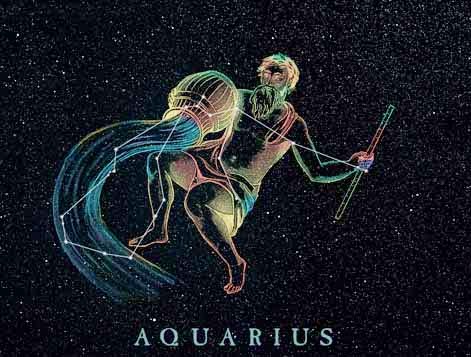
The Age of Aquarius will begin with the inauguration of the millennial reign of Christ upon the earth. Regarding this age, we are informed of the following by the prophets Isaiah and Habakkuk.
Isaiah 11:9
“They will not hurt or destroy in all My holy mountain, for the earth will be full of the knowledge of Yahweh as the waters cover the sea.”
Habakkuk 2:14
“For the earth will be filled with the knowledge of the glory of Yahweh, as the waters cover the sea.”
We previously read the testimony of David in the Psalms who said, “The heavens are telling of the glory of God; And their expanse is declaring the work of His hands. Day to day pours forth speech, and night to night reveals knowledge” (Psalms 19:1-2).
Here is a heavenly symbol depicting the very act of pouring forth the knowledge of the glory of Yahweh upon the earth. What a remarkable testimony Yahweh has set in the heavens. With precision He has caused the movements of the heavens to show forth His plan of the ages. With exact timing the precession of the equinoxes are leading us from one age to another to correspond with the works of God.
Heart4God Website: http://www.heart4god.ws
Parables Blog: www.parablesblog.blogspot.com
Mailing Address:
Joseph Herrin
P.O. Box 804
Montezuma, GA 31063


Amazing article Joseph!!!